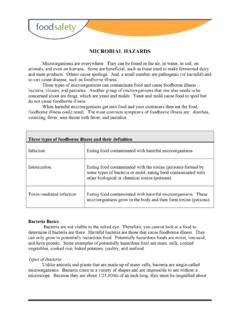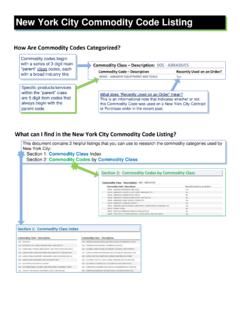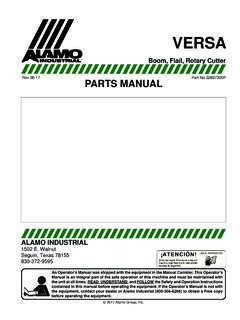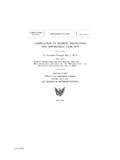Transcription of What’s the Difference Between an OSHA Rule and …
1 1 What s the Difference Between an osha Rule and an ANSI Standard? By Glenn Demby, Esq. This article is being reproduced for the American Society of Safety Engineers (ASSE) newsletters and website per the permission of Bongarde Media. This story was authored by Mr. Glenn Demby and first appeared in the newsletter Safety Compliance Insider. It s copyrighted and reprinted with permission of Bongarde Media. If you re trying to get your safety program to comply with workplace health and safety requirements, the first thing you need to do is figure out what those requirements are.
2 That s not as simple as it sounds. Just reading all of the osha regulations and standards and state laws isn t enough. To determine what your legal obligations are you must also account for the technical safety standards published by organizations such as the American National Standards Institute (ANSI, the American Society for Testing and Materials and the National Fire Protection Association (NFPA) (for simplicity s sake, we ll refer to all these organizations collectively as ANSI). Like many safety directors, you may be confused about ANSI standards.)
3 It s not just that the standards are highly technical documents; nor is it the fact that there are literally hundreds of them in existence. What makes ANSI standards so troubling to safety co-ordinators is uncertainty about their significance. Is an ANSI standard the same thing as an osha standard or a law? Are you required to follow it? What happens if you don t? This article will sort out the confusion. It will explain the legal impact of ANSI standards and their impact on the liability of you and your company. After reading the story, you ll have a much clearer idea of how to factor the various ANSI standards into your compliance strategy.
4 What Are ANSI Standards? ANSI Standards are detailed, technical documents that provide rules , guidelines or characteristics for a product or process. One potential source of confusion is that standards look just like laws. In fact, many ANSI Standards cover the same issues addressed in provincial OHS laws. For example, ANSI standards cover protective headwear just like osha does. But there are some important differences . One Difference has to do with the scope and character of the information. osha laws typically set out only a general framework, procedure and/or set of standards to guard against a hazard.
5 The osha standard fleshes out the law. The CSA Standard is usually consistent with the law and standard but goes into much greater depth. It provides the technical, nuts-and-bolts details that osha leaves out. Many ANSI Standards also go much further than the legal standards do in protecting workers. The Four Principles of ANSI Standards A good way to come to grips with ANSI Standards is to remember these four principles: 1. An ANSI Standard Isn t a Law osha laws and government standards are always mandatory; ANSI Standards are generally voluntary.
6 Organizations like ANSI are typically private groups made up of industry representatives, technical experts and policy makers. They get together in committees and try to reach a consensus on safety matters. They re not governmental organizations and they have no power to force employers follow their standards. All they can do is make recommendations. 22. ANSI Standards Can Become Mandatory Although ANSI Standards are voluntary, they may become mandatory through a process called incorporation by reference. Incorporation by reference is a fancy term for a simple process.
7 It happens when an osha standard cites the ANSI Standard and says that you have to follow it. In effect, the ANSI Standard becomes part of the law. So if you don t follow it, you face prosecution and fines. Example: The osha standard for head protection says that protective helmets purchased after July 5, 1994 shall comply with ANSI `American National Standard for Personnel Protection-Protective Headwear for Industrial Workers-Requirements. [Section (b)(1)]. Many of the osha standards incorporate one or more ANSI Standards by reference.
8 The most common way to incorporate an ANSI Standard by reference is to adopt the entire standard. But there are other approaches. For example, the osha standard might incorporate only a part of the ANSI standard. osha might also adopt the standard but change a specific part of it. Example: The osha Fire Brigades standard says that the performance, construction and testing of fire-resistive coats and protective trousers shall be at least equivalent to the requirements of the National Fire Protection Association standard, NFPA No.
9 1971-1975, but then lists a couple of permissible variations from the NFPA requirements [Section (e)(3)(ii)(A) and (B)]. 3. You Can Be Cited for Not Following Voluntary Standards Not all ANSI Standards get incorporated by reference into osha standards. For example, NFPA Standard for Electrical Safety in the Workplace (NFPA 70E), isn t incorporated into any osha law or regulation. But osha may still cite you for not following the standard even though it s not mandatory to do so! This seems unfair and illogical. But it s true. Explanation: osha standards typically establish the general standards employers must meet without specifying how.
10 osha gives the employer discretion to decide how best to achieve the standard s goals. But osha --and the courts--do say how they expect employers to use the discretion provided by the standard. Among other things, employers are expected to consider any existing consensus standards, that is, non-legislative standards adopted by industry and other non-governmental organizations. Even though these standards aren t legally required, they represent a consensus on what experts consider safe. So osha might regard an employer s failure to adopt a voluntary standard relating to an osha requirement as evidence that it didn t take reasonable steps to comply with the standard.






